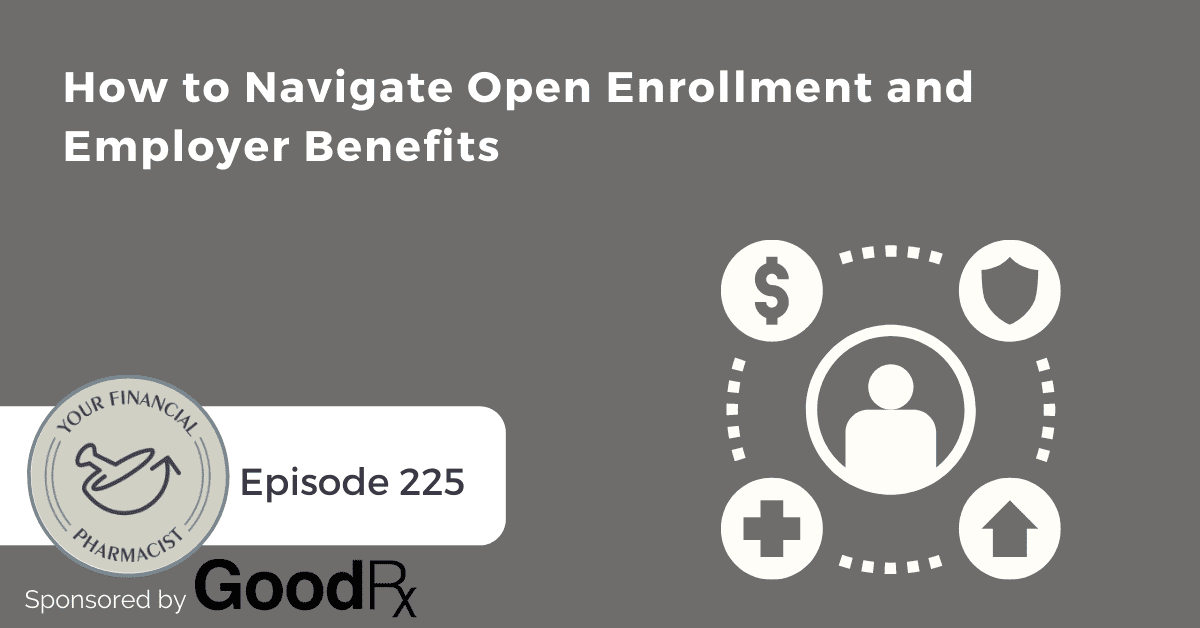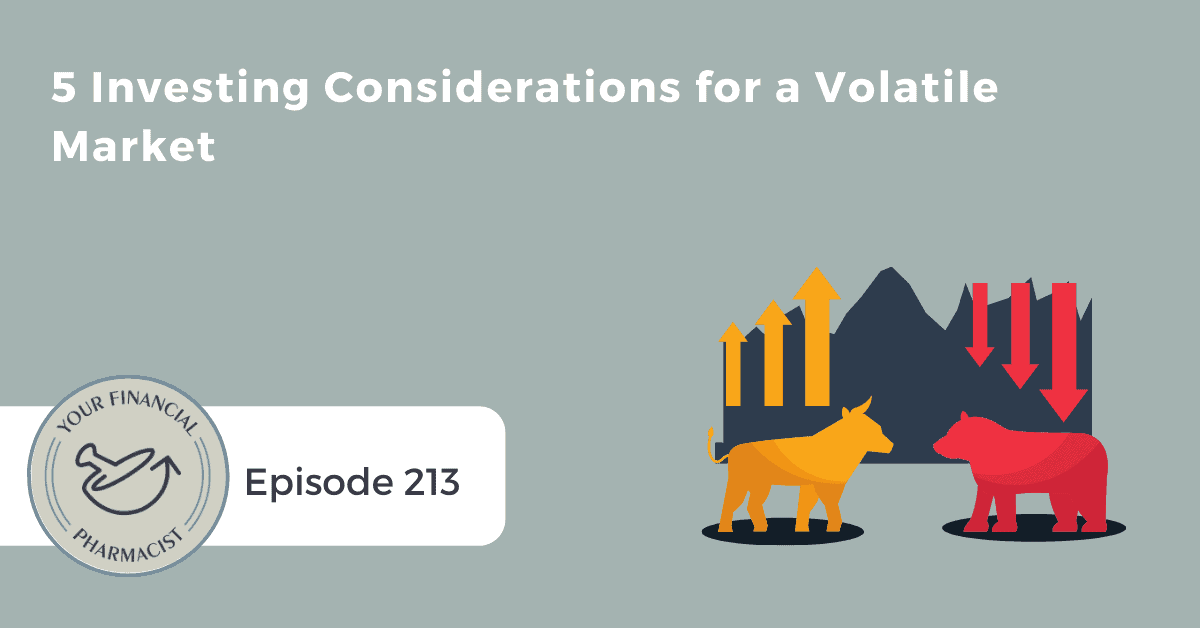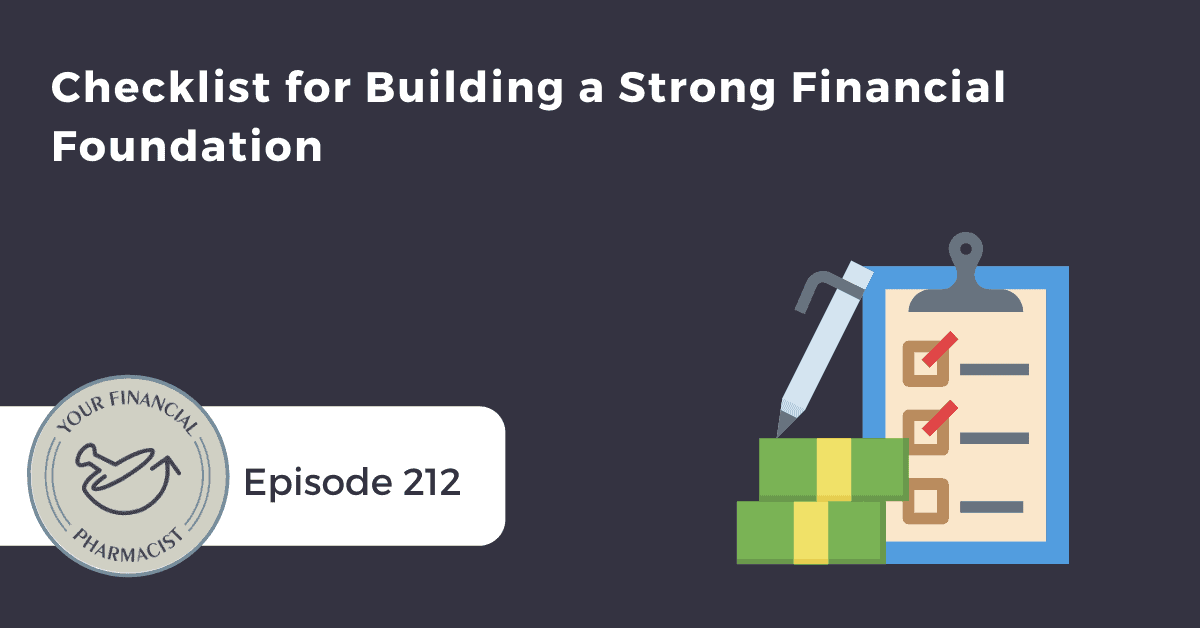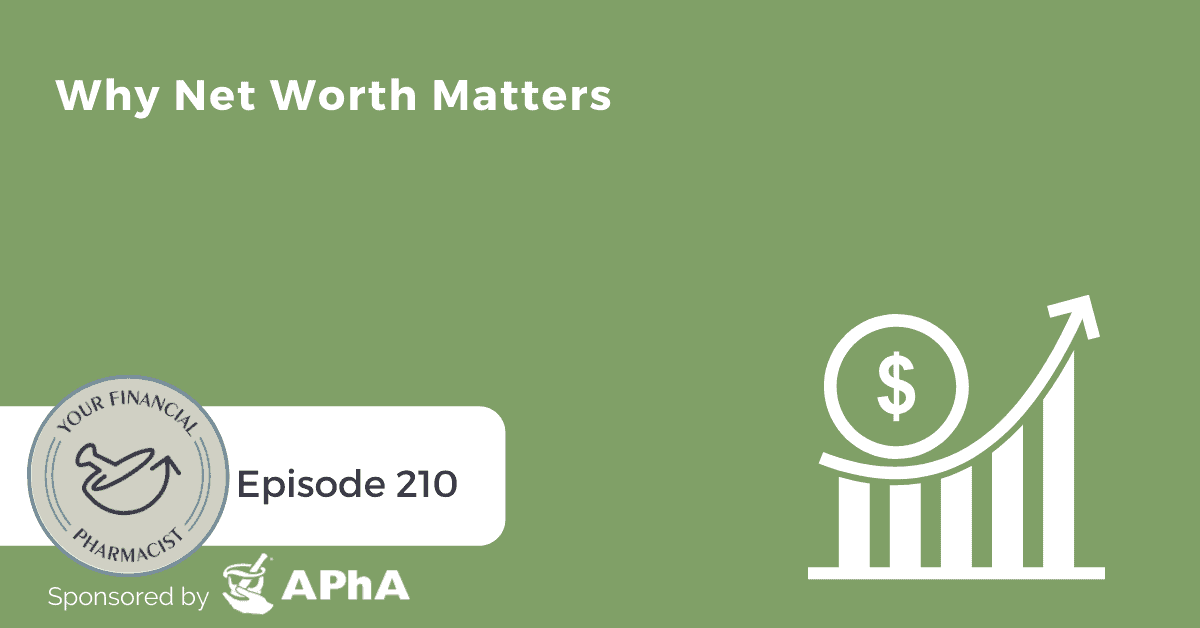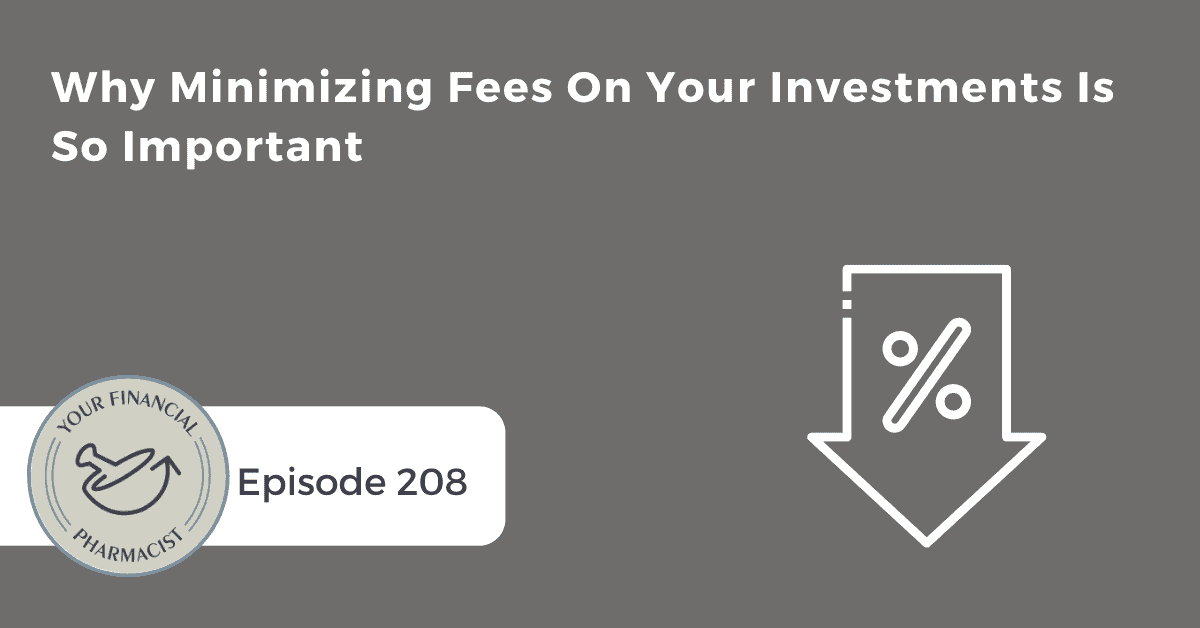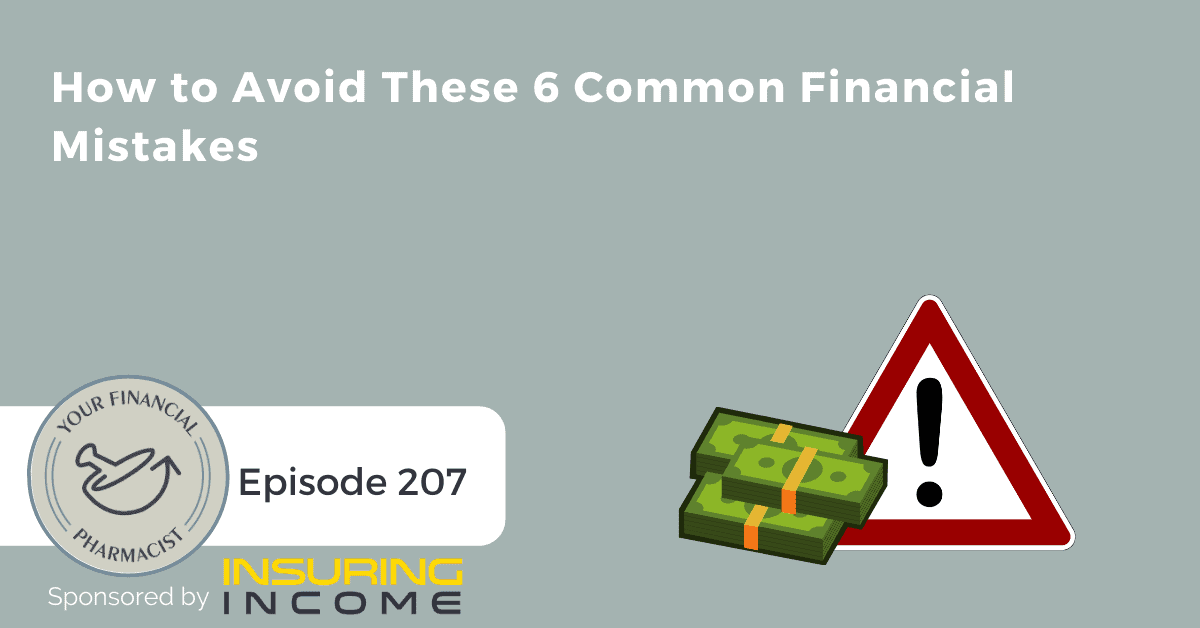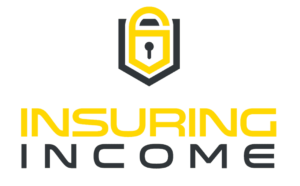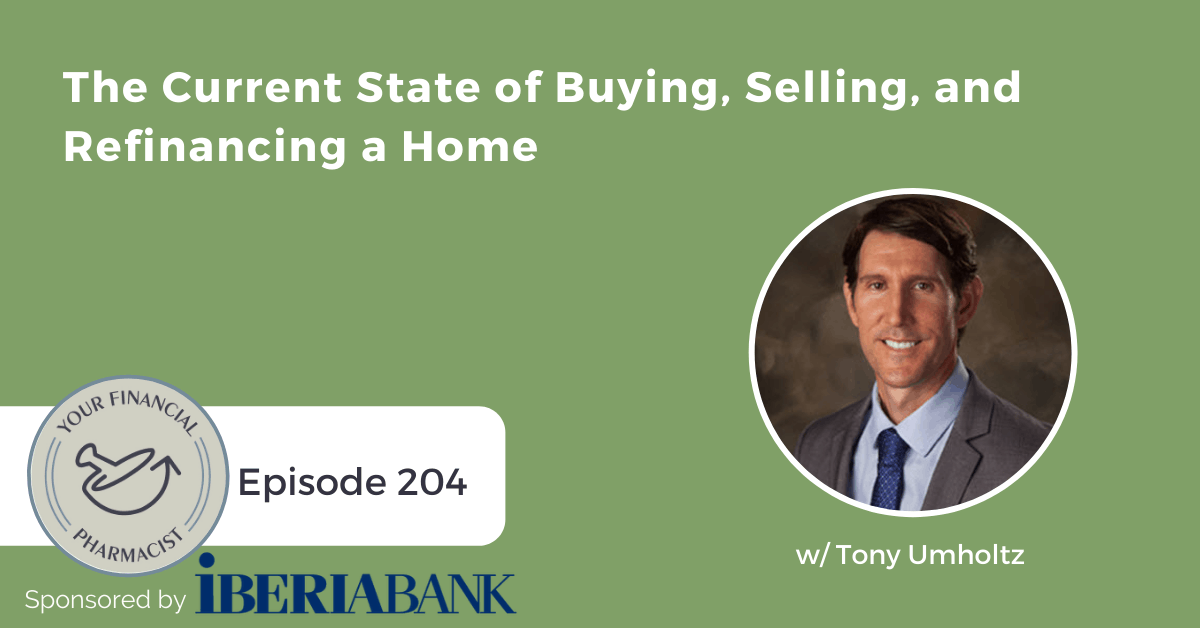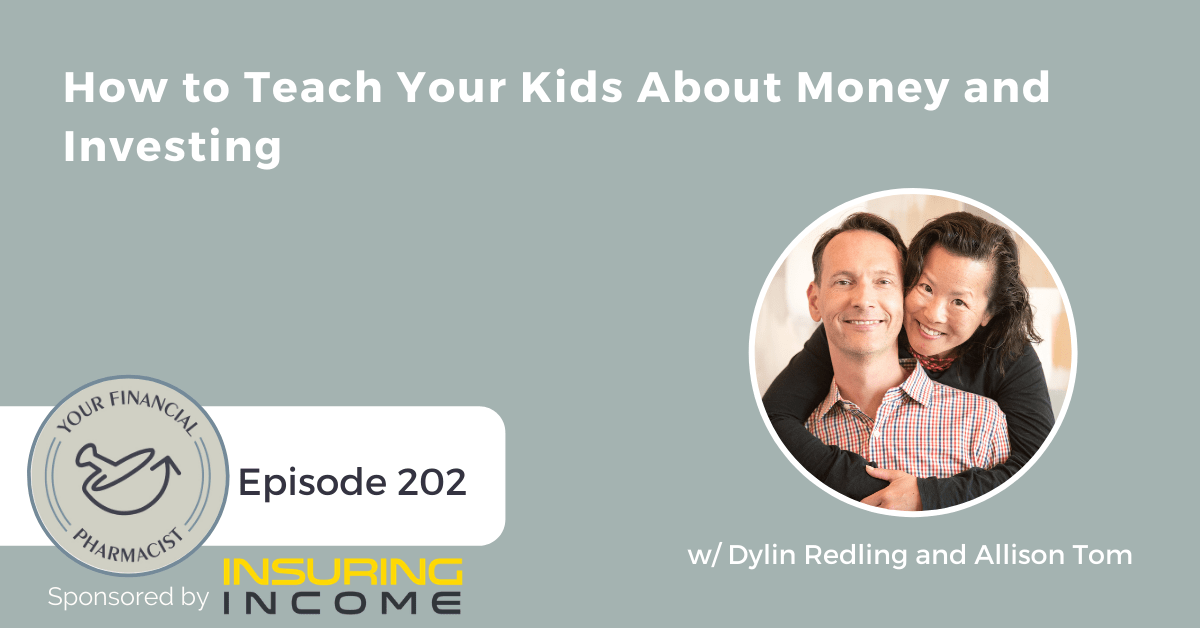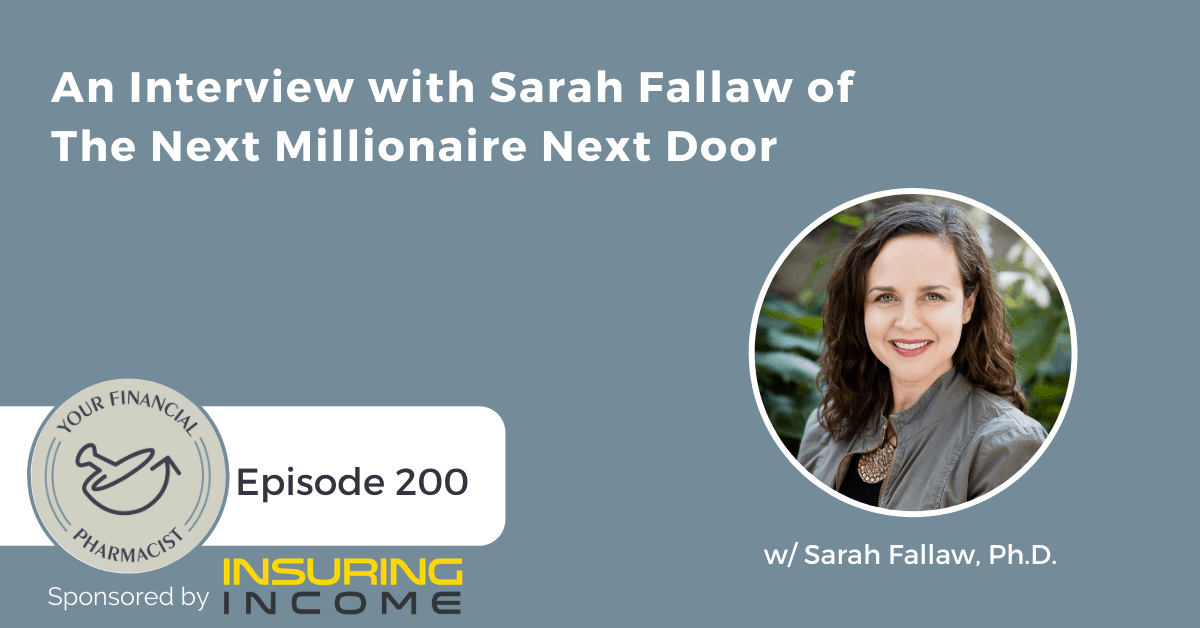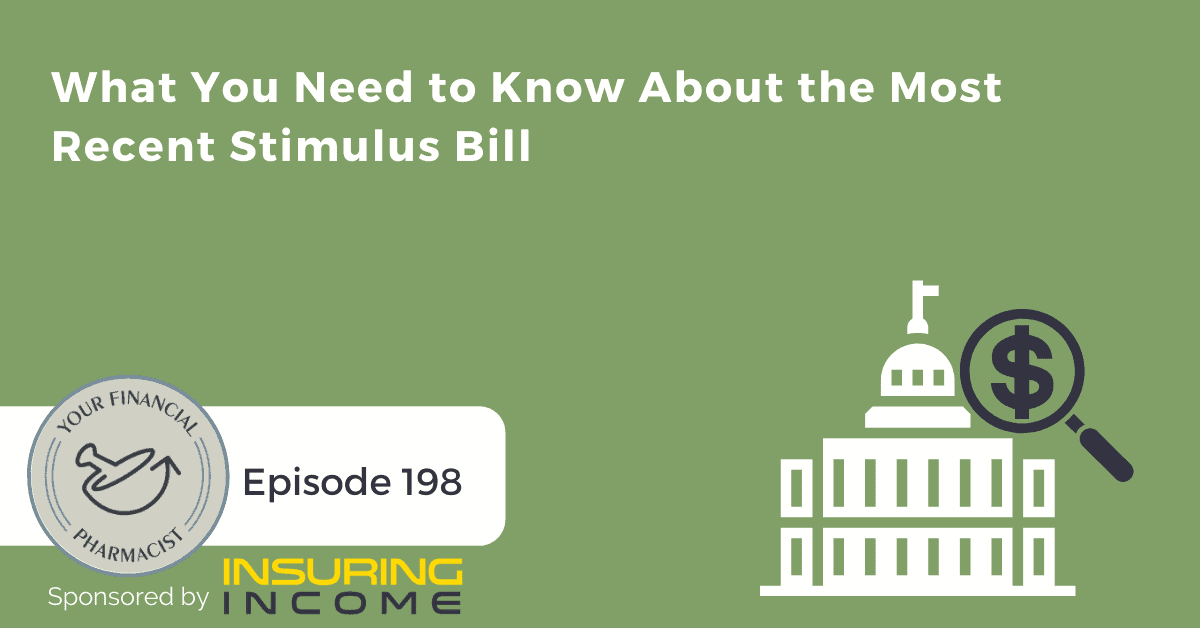How to Navigate Open Enrollment and Employer Benefits
On this episode, sponsored by GoodRx, Tim Baker, YFP Co-founder and YFP Planning Director of Financial Planning, joins Tim Ulbrich to talk about open enrollment and evaluating employer benefits. Tim and Tim dig into:
- Considerations for choosing a health insurance plan
- How to determine whether or not your employer-provided life and disability insurance is sufficient (one of the most common questions we get)
- Understanding the differences between an FSA, Dependent Care FSA, and HSA
- What to be looking for when putting money into your employer-sponsored retirement plan.
Summary
This week on the Your Financial Pharmacist Podcast, Tim Ulbrich sits down with YFP co-owner and Director of Financial Planning, Tim Baker, to discuss open enrollment and the process of evaluating employer benefits. As you go into making your benefit selections for 2022, Tim and Tim share some considerations for choosing a health insurance plan and how to determine whether or not your employer-provided life and disability insurance are sufficient. Tim and Tim provide a general overview into understanding the differences between an FSA, Dependent Care FSA, and HSA and what to be looking for when putting money into your employer-sponsored retirement plan.
Whether you are reviewing your benefits for the first time or are a seasoned professional with open enrollment, there are many factors to consider. Pharmacists may not think to consult with their financial planners when it comes to open enrollment or the process of evaluating employer benefits, but these decisions affect the financial plan. When choosing a plan for the coming year, pharmacists should consider future life events or changes impacting money spent on medical expenses such as a child being born, marriage or divorce, coverage for a significant other, or a child aging out of medical coverage. The open enrollment period is a time to review history in medical spending, how much is spent out of pocket, and how to optimize benefits and cost savings based on those findings.
Tim Baker touches on life insurance and disability insurance, how to calculate your total need, transferability issues to consider when deciding whether or not to purchase a policy outside of your employer policy, and tax considerations.
Tim Ulbrich closes out by breaking down the differences between an FSA, DCFSA, and HSA. He also touches on retirement savings accounts in conjunction with open enrollment and the opportunity to re-evaluate investing and savings goals and how each fits in with the financial plan.
Mentioned on the Show
- YFP Planning: Financial Planning for Pharmacists
- Book a free Discovery Call with YFP Planning
- GoodRx: Get the Exclusive Report on the Current State of the Pharmacy Profession
- YFP 044: How to Determine Your Life Insurance Needs
- YFP 045: How to Determine Your Disability Insurance Needs
- Your Financial Pharmacist
- YFP 165: The Power of a Health Savings Account
- Why I’m Not Using My Health Savings Account to Pay for Medical Expenses
- Ask a YFP CFP© #84: What can I do about the fees on my HSA account?
- YFP 074: Evaluating Your 401k Plan
- YFP 208: Why Minimizing Fees On Your Investments Is So Important
- Your Financial Pharmacist Disclaimer and Disclosures
Episode Transcript
Tim Ulbrich: Tim, glad to have you back on the show.
Tim Baker: Yeah, good to be here, Tim. Looking forward to getting into open enrollment discussion. ‘Tis the season. So yeah, I’m ready for it.
Tim Ulbrich: ‘Tis the season indeed. Fall is in the air officially here in Ohio, which does mean it’s almost time for open enrollment and ensuring that we’re taking the time to understand and maximize employer benefits. And I think whether someone is reviewing their benefits for the first time, whether that’s accepting a new position, going through another round of open enrollment, a lot to consider here, including insurance, retirement accounts and HSAs, FSAs, to name a few. So Tim, our team at YFP Planning includes employer benefits as a part of the planning process, perhaps an area that folks don’t necessarily associate working with their financial planner on. So how does this part, employer benefits, factor into the financial plan? And why is it so important that we’re looking at it in the planning process?
Tim Baker: Yeah, I think this is another area, Tim, where like when we say, “comprehensive,” we mean comprehensive. And it’s just like kind of the same conversation with things like home purchase. Most financial advisors are not going to kind of walk you through kind of the A-Z of buying a home because most of the time, a financial advisor is working with people in their 50s, 60s, 70s, right? And the reason for that is because those are the people that have assets, and that’s how they charge their fee. We have many, many, many clients that are in their 20s and 30s. And things like home purchase is really important and is often a big step in their financial journey and their financial plan. So we kind of take the time to go through that based on, I know you’ve said it, I’ve said it, we’ve messed those transactions up in the past, and we just don’t want to see our clients do the same thing. So open enrollment is kind of the same thing. A lot of financial advisors don’t really talk about this stuff because if you’re working with people in their 50s, 60s, like they’ve done it dozens of times, right? So they’ve gone through this. And a lot of our clients haven’t. You know, it’s not something that is kind of what we understand. And so to define open enrollment, open enrollment is the period of time where you can purchase or apply for health insurance for the upcoming year without a qualifying event. And usually a qualifying event is something like a marriage or a divorce or a birth of a child. So it’s typically very centered on the health insurance plan because that’s the big piece of the benefits. But then what the employer does is kind of have you opt out of other benefits that they might offer, which might be life insurance, disability, I’ve even seen things like pet insurance and things like that. You know, some things that are not insurance-related could be like a legal benefit. So that’s what this is is open enrollment. And it’s important because your employer benefits are a major component of your compensation package. And you know, this is kind of the conversation that goes back to things like salary negotiation is I’ve seen clients, they’ll say, “Hey, I’m making $110,000,” and they get an offer for $120,000 but they take a major step back with regard to their total compensation because of the benefits that are associated with that. I think it’s really important to understand what the employer benefits are and how to assess that. So that’s really what’s at stake here is really understanding that piece. And we know this, Tim, because when we plan to hire someone, we know that it’s not just about the salary pay. We apply a multiple on top of that because we know that the benefits that we’re going to provide for the employee are going to be above and beyond that. So that total cost or what I would say is an investment in that person is really beyond the salary. So this is what is really that bell to that. We’re trying to assess an an employee to say, OK, how can I best optimize this part of my compensation. And I would say that there is a lot, you know, a lot of people that don’t necessarily fully optimize this part of their financial plan or give it the attention that it needs because it sneaks up on us or bad information or what have you. So that’s really kind of the overall picture here of what it is and why it’s important.
Tim Ulbrich: Yeah, and Tim, I think when you say sneaks up on us, bad information, it’s important I think for folks, basic stuff before we jump into individual benefits, you know, know your dates, obviously what’s the time span. You know, a lot of employers, depending on how they organize this, will do informational sessions, open Q&As, one-on-ones, group, and some of that might be automated, depending on the system and the platform they’re using. But making sure, understanding the dates, you know, simple things, how much time do you have if you’re going to be on vacation, things like that, making sure you can coordinate with HR. And then also, you know, just taking a look at your pay stub and your benefits. What do you currently have? And really taking a pulse on — and I think just a chance to go back and what’s gross pay, what’s net pay, what’s coming out in benefits, and taking this time that comes around every year as a chance to revisit some of these things that we want to be looking at often. And then of course, just thinking about upcoming changes, right, that might be happening. You know, I think of things like children that might be beneficiaries on the healthcare side, aging out if you think about 26 or folks that might be expecting or perhaps getting married, things that might have an impact on their benefits, considering those things as you’re in the benefits selection. And then of course just refreshing and updating the evaluation of who are the beneficiaries that are listed on certain policies. Tim, I want to start with health insurance. You know, I think it’s the one that typically carries the biggest price tag as we think about it relative to the other insurance and typically carries more options than things like dental and vision and life and disability, which I think for many employers it’s more of a one-way type of option. So the big question here is how do I determine which one to get? And of course, all plans are created differently but when folks are looking at these and you’re evaluating the deductibles and maximum out-of-pockets and premiums and copays and coinsurance, unfortunately, it’s a system that even though our audience is comfortable with all of those numbers because they live in it in the job that they’ve done or have been trained in it previously, there’s just a lot to consider. And if you look at plans, let’s consider a three-tiered plan where you’ve got like a bronze, silver, gold option, you know, you’re looking at OK, less out of pocket, more out of pocket, better coverage, but perhaps I could have lower out of pocket and I could use that money elsewhere. Like general framework, how do you begin to help clients think through this decision and not just look at it in a silo but also consider it in the context of the rest of the plan?
Tim Baker: Yeah, so I think it’s — you know, everyone can say it with me — it depends, right? So you know, I think a lot of it depends on past history or — you know, you mentioned a few things like what’s kind of on the horizon? Is it getting married or having kids? And some of those will allow you to kind of elect insurance outside of the open enrollment period. But those are typically qualifying events. But you know, an example is when we had Liam, when Shea was pregnant with Liam, we opted out of the bronze package, you know, the HSA plan to more of a gold package because we knew that the doctor bills and the hospital bills were going to be there. Our thought process was, you know, although in most cases we’re not going to the doctor a lot, you know, during a normal year, well, electing to a higher deductible plan, which means less coming out of our paycheck but then when we do go to the doctor, there’s going to be potentially more coming out of our pocket. So we did that to get in front of it a little bit. And you know, that’s really important from a planning perspective and kind of mitigating as much of the costs — and we probably saved ourselves if we did the math $1,000 by doing that. So that’s an important part of the plan. Now, sometimes things are going to come up and you’re just not going to — you know, it’s kind of like that emergency fund. You’re just not going to know for the future. But I would say is it’s a little bit of an exercise in looking at your past history, so looking at how often you’re going to the doctor and how often you’re reaching into your pocket to pay for things like copays and things like that. But then also projecting it forward, so that’s kind of where the conversation starts is that, you know, if you’re a younger, healthy professional and you’re not really going to the doctor, then you probably should really consider kind of a bronze, high-deductible, HDHP plan and couple that with the HSA, which we’ve said is a great forum to stash dollars. If you’re looking at regular doctor visits because of a chronic issue or something like that, that’s not going to be for you, regardless of your age. You just know that you’re going to be in and out of the doctor’s office. So I think it’s really looking at, again, kind of the budget and seeing what money has been spent on healthcare costs in the past and then what you think, project those going forward. And like I said, like this is not — it’s important, but these are taking it like snapshots one year at a time. So you can — like after Liam was born and the medical expenses were gone, then we went back to the high-deductible plan with the HSA. So I think it’s really important to kind of take stock of kind of your history, your medical history, your spending on healthcare, to form the baseline of your decision in that realm. The other comment I would make, Tim, is not all 401k’s are created equal. And as many of us know, not all health plans are created equal. So some are really, really great, and some are really, really terrible. And sometimes, that has to do with the size of the organization, sometimes the economies to scale, the bigger that you are, the less that each participant pays, whether that’s the 401k or the health insurance plan. So you kind of have to work with the sandbox, you know, that you’re playing in, so to speak, and something that can be very much out of your control.
Tim Ulbrich: Yeah, and I think, Tim, your example of Liam is a great reminder of not putting open enrollment on auto pilot.
Tim Baker: Yeah.
Tim Ulbrich: And I think that’s what we’re trying to stress here is like, using this as a chance to re-evaluate each year, you know, what happened last year? What worked last year may or may not be what makes sense for this year for a variety of reasons. And I think this is certainly a place where we want to be evaluating what does the cash position look like? What does the reserves look like? And how do we feel about that? Especially if we’re going to be opting into a high-deductible health plan, you know, thinking worst case scenario — hopefully never happens — looking at those out-of-pocket maxes and really asking yourself, how comfortable are we with that happening? How does that make us feel? And could we weather that storm if it were to come?
Tim Baker: Yeah, and you know, and we’ve had some tough conversations with clients that are deep in credit card debt and they really need as much of their income to kind of like right the ship and get going, so sometimes it means sacrificing or being uncomfortable here. You know, one of the things I look at is like if we look at all the debts that are out there, medical debt is not necessarily a bad debt in terms of like they reformed a lot of things with it hurting your credit because it’s kind of been a nightmare, you’re typically not gouged with higher interest rates and things like that. So typically more forgiven. I would even say push back on a lot of medical debt because it’s wrong. I think Tim, you had a story about that when one of your sons was born. So there’s a little bit more give I would say than some of these other ones that goes like right to collections and you’re in a lot of trouble. So it’s kind of — this is all about like mitigating the risk and trying to understand where can we give a little bit so we’re OK.
Tim Ulbrich: I want to shift gears, Tim, to life and disability. Probably one of the most common questions that we get is, do I need to purchase additional life and disability insurance beyond what my employer covers? And of course the answer is it depends on a large part of the individual’s situation and what they have going on and what they’re trying to do with those policies and so forth. But you know, general thoughts and discussion on how one goes about making this decision in terms of understanding what coverage is there from an employer standpoint, determining what total coverage may be needed, and some of the gap and differences between an employer plan and if they purchased a policy out on the open market.
Tim Baker: I think if we look at most pharmacists out there, you know, professionals that are making a six-figure salary, I think there’s going to come a time when there probably is a need to purchase policies outside of what the employer provides. Now, the problem with the financial services industry is that a lot of “financial advisors” are trying to push those policies on a young professional when they probably don’t need them. That’s when you’re a pharmacist that has maybe six figures of debt that’s going to be forgiven if you die or are disabled with no dependents and really, you know, not much on your balance sheet. So there’s kind of like this gap of do I really need this? Or can I just make do with what my employer provides? I’ll say this about the employer-provided policies: Outside of health insurance, which is a health plan, I would say that things like life and disability insurance are not plans. They’re really perks. So they’re meant to supplement or meant to provide some type of benefit that will help the employee but also it’s a way to kind of retain you and things like that. So I really view these as perks and not necessarily plans. I would say, to your point, Tim, I think it’s really looking at the individual and say OK, does it make sense to buy a policy outside of that? Most employers will provide some type of life insurance benefit, whether it’s something like $50,000 or one or two times income, which you can then elect to either increase your coverage or not. I think the downside of that is, you know, if you’re working for an employer as a 30-year-old and you have all of your eggs in that basket and you’re saying, “Hey, I have $1 million” or a lot of times, they’re capped. Most times, pharmacists need a lot more than what their employer can provide. So that’s one of the drawbacks. But if you’re working with that company for 40 years and then you leave to go to another organization, which maybe that isn’t provided or it’s a lot less of a benefit, you have a gap, then you’re going out in the market 10 years older where you’re paying a lot more for that particular policy. So that’s one of the things that — sometimes they’re portable, meaning that you can take them with you, and sometimes they’re not. So for both the life and disability, you know, it’s really looking at your own situation. Just like open enrollment itself, this is one of the things that often overlooked, just insurance. And I know we’ve probably done a podcast in the past about what’s proper life and disability and things like that.
Tim Ulbrich: Yep.
Tim Baker: For the disability, the coverage is typically going to be a percentage of your income. And again, it could be capped, and some employers will offer both long-term and short-term disability. You know, both are great. But you know, oftentimes, because of one reason or another, there’s going to be a gap in the coverage either because of taxes or just that a pharmacist, what they make and what most professionals will say that you need to kind of cover down and typically, that can be anywhere from 50-80% of what your income is, that there is a need to go out onto the open market and buy individual policies. But from an open enrollment perspective, I think if you don’t have those policies, it’s really important to understand, you know, what is there for you? And what can at least tide you over until you get those policies in place? And again, it’s one of those things where it’s like, it’s not important to you until it’s important to you. And it’s really hard to kind of, to show that to clients unless they’ve experienced that pain themselves or a close family member.
Tim Ulbrich: Yeah.
Tim Baker: But it’s going to be a really important piece of protecting the overall financial plan, which is — this is really what this is all about is, you know, insurance is really protecting the financial plan from a catastrophic event and ensuring that you can continue to build wealth and survive into the future.
Tim Ulbrich: Episode 044, Tim, How to Determine Life Insurance Needs, 045, How to Determine Disability Insurance Needs, two that we’ll link to in the show notes. We’ve got more information on the website as well, YourFinancialPharmacist.com. Tim, I think one of the common mistakes I see made here just relating to that discussion on gap in coverage is not digging into the policies to really understand, you know, life insurance is maybe the most obvious example where if you have a policy — if you have a need for life insurance and you have a term policy that’s offered for $50,000 or $100,000 or one times salary or two times salary, typically, those have a cap on them. For many folks, there’s going to be a gap and a shortage. And I think this is where, you know, sitting down one-on-one with someone to really calculate the total need, think about the transferability issues that you mentioned and what does it mean if you pick up employment, tax considerations, and really getting into the weeds of some of the nuances of the policies and things like own occupation, we’ve talked about that before and its importance. And again, thinking about how this fits in with the rest of the plan. And just a shoutout here to our fee-only financial planning team at YFP Planning, this is really where I think the value of fee-only comes in in that really sitting down with someone to determine what is their true need in their best interests. Not too much coverage that there’s dollars being spent that could be put elsewhere in the financial plan, but making sure we’re also not exposing the plan to unnecessary risk.
Tim Baker: Yeah, I mean, you know, this — what we’re talking about here are products. Like insurance is a product. So any time that you talk about dispensing a device, “Hey, Tim, you need life insurance,” and you say, “OK, great. Like where do I get it?” Like we can sell you this product. There’s going to be a conflict of interest. So having someone that is a fee-only fiduciary that is not further enriched by the advice that they’re giving, you know, strips away a lot of that, well, am I being advised in my best interests or in the advisor’s best interests, the one that’s advising me. So that’s I think the beauty of fee-only.
Tim Ulbrich: One example I just want to give here, I just pulled up, Tim, our long-term disability coverage that we added recently for the YFP team.
Tim Baker: Yeah.
Tim Ulbrich: And you know, if you look at it on kind of the main benefits platform, it says, “60% monthly income up to $6,000.” But this is an example where digging deeper is so valuable. You know, you get into things like what is the definition of earnings? So our policy, it’s base wage. So how you’re compensated could have an impact here.
Tim Baker: Yep.
Tim Ulbrich: What’s the elimination period or the timeframe from when the disability happens to when the benefit starts to pay out? Here, it’s 90 days. But if it’s shorter than that, perhaps longer than that, what’s the game plan to fund. Does it have own occupation coverage? We’ve talked about the importance of that before. What’s the maximum benefit? Our policy goes up to age 65. And then things like coverage restrictions, other incentives. So really, just a reminder of this time period and using this point here to really dig into this information and read the policies.
Tim Baker: Yeah, you know, and again, going back to those episodes you mentioned there, that’s where we kind of talk about the nitty-gritty, but I think the beautiful thing about this is like when we’re reviewing this and we kind of look at the — kind of go through the open enrollment optimization stuff is like as a planner, I’m looking at your balance sheet. So I’m like, alright, does it make sense to bolster — you know, because a lot of these, you can opt in. So like our policy doesn’t do this, but a lot of policies, they’ll say, “The employer pays for a 60% benefit of your earnings.” But then you can opt in to get that up to 80%. So you pay an additional — you pay out of pocket out of your paycheck for that additional 20%. If I’m looking at your balance sheet, Tim, and I’m saying, “Man, you have plenty of cash,” I would say, “Let’s not opt into that.” Or we might say, “Let’s do it,” because we know because the employer is going to pay for it, that that benefit’s going to be taxed.
Tim Ulbrich: Yep.
Tim Baker: If the employer pays for the benefit, it’s going to be taxed. That’s the gap. You know, so the idea is looking at your situation and overlaying what’s out there. I think the open enrollment, what I say is we want to look at the things that you’re paying for and say, does it make sense for you to be paying for it? I see a lot of AD&D insurance, and I kind of look at this as like — and again, this is not advice — but I kind of look at those as like when you buy something at Best Buy and they ask you about the warranty. You know, most of the time, you say no because it’s just not worth the money. Some of these things in open enrollment, it’s the same thing. It’s like AD&D, for those to pay out is very rare. So even if it’s $2 per pay period, I’m like, I just don’t think it’s worth it. So we’re trying to make sure that you’re not paying for things that don’t necessarily provide you much benefit, much utility. But then you are paying for things that do. And you know, kind of finding that Venn diagram of sorts to make sure that, again, we’re fully optimized with regard to this part of your compensation package.
Tim Ulbrich: AD&D, for folks that are wondering, Accidental Death & Dismemberment insurance.
Tim Baker: Oh yeah. Yep.
Tim Ulbrich: Tim Baker dropping some financial lingo here.
Tim Baker: Sorry about that. Yeah.
Tim Ulbrich: Tim, next I want to talk about FSAs, dependent care FSAs, especially since we’ve had some changes that have happened there as well as HSAs. And we’ve talked probably among these to the greatest extent, we’ve talked about HSAs because of the value of what that can provide as well as these other options. And we’ve talked about it on the podcast, we’ve got some blog posts, Episode 165, The Power of a Health Savings Account, also have an article on the blog, which we’ll link to, about really more of the strategic investing side of an HSA if you’re able to do that. So Tim, high level overview, FSA, dependent care FSA, HSA, and some of the differences and considerations for these accounts.
Tim Baker: The very crude way that I remember the difference between FSA and HSA is FSAs are really use-or-lose. So when you fund these with pre-tax dollars, if you don’t use those monies for the purposes of healthcare for an FSA for healthcare or dependent care for a dependent care FSA, you lose it. So it’s F-udge. Like I don’t get — you don’t get to use that money. Whereas the HSA, this is — can potentially be an accrual account, meaning that year over year, you can stack Benjamins and hopefully one day becomes that kind of stealth IRA that we talk about that has that triple tax benefit. So like I said, we’ve talked about the HSA ad nauseum. It has to be paired with a high-deductible health plan. You know, you can put the money in. It has a triple tax benefit, which means it goes in pre-tax, it grows tax-free so you can invest it like an IRA, and then you can distribute it in the near term for approved medical costs or when you reach a certain age, you can use it basically for whatever. So that’s the beauty of the HSA. But you know, again, it only works or you only have access to it when it’s paired with a high-deductible health plan. The FSA for healthcare is similar, but very different. So you’re allowed to use — you’re allowed to fund it with pre-tax dollars, meaning if you make $100,000 and you put $1,000 in there, you’re taxed on as if $99,000. So I think the limits for FSA for 2021, I think it’s like $2,750.
Tim Ulbrich: That’s right. Yep.
Tim Baker: Yeah. So the idea is that what you’re trying to do here — it’s a little bit of a game of chicken. So what you’re trying to do is really, again, see into the future and say, “OK, what do I know is a baseline that I’m going to use on my out-of-pocket healthcare expenses?” And if you know for sure that you’re going to spending $2,000 on that, then you should fund it with $2,000. And typically, there is a little bit of give at the end of the year where you can either carry some over or you have some time into the New Year to use it on.
Tim Ulbrich: Two months or —
Tim Baker: Yeah. And every plan is going to be different in its design. So you might be loading up on kind of some of the over-the-counter stuff. I’ve had a client buy a bunch of stuff for like contacts and things like that. So it’s going to be really important to kind of — again, this goes back to the spending plan, the budget, to understand what have you been spending in the past? Is that going to be indicative of what you will spend in the future? And then fund that with at least that baseline amount so you don’t lose it. The same thing can be said for the dependent care FSA. So this is a pre-tax account that you can fund that is used for care for your child who is age 13, for before- and after-school care, babysitting, nanny expenses, daycare, nursery school, preschool, summer day camp, and then also care for a spouse or a relative who is physically or mentally unable to care for themselves and lives in your home. So this money — this has actually been amended under the American Rescue Plan Act. So I think for single and married filing jointly couples, the pre-tax contribution limit went from where you could $5,000 a year, now it’s I think $10,500.
Tim Ulbrich: Significant jump. Yep.
Tim Baker: Yeah, very significant. So the higher limits apply to the plan year beginning Dec. 31, 2020 and before Jan. 1, 2022. So it is a temporary thing, but it allows you to park some dollars that you would otherwise — so if you’re in a 25% tax bracket, it’s as if you’re saving 25%, kind of thinking about it that way. So that’s what really — and for the FSAs, unlike the HSA, the FSA is — it has to be provided by the employer. I think we had a question on the Ask a YFP CFP about the HSA. And you don’t have to necessarily go through your employer. Sometimes, the employer doesn’t offer it. So you can go out and set up your own HSA. The FSA has to be provided by the employer for you to have access to it. So that’s really important. Again, these are all going to be — when you elect it, it’s going to take money out of your paycheck and basically fund these accounts for the appropriate purpose.
Tim Ulbrich: Yeah, and this to me is where when we’ve talked with Paul Eikenberg, our director of tax, and working with our clients, one of the things he talks about here is these being untapped areas of potential.
Tim Baker: Totally.
Tim Ulbrich: And so I think there’s a lot of low-hanging fruit in the financial plan. And I think really evaluating these and perhaps the dollars of any one don’t jump out as being super significant, but I think as we start to add these up with other strategies, there certainly is value. And Tim, you had mentioned we did tackle a question recently on Ask a YFP CFP 084. The question was about fees on an HSA account, but we did talk about the opportunity to access an HSA account independent of the employer. So we’ve talked about health insurance, we’ve talked about life and disability, we’ve talked about FSAs and HSAs and dependent care FSAs. I want to wrap up our discussion by retirement saving options. And I think, again, this is an opportunity to take a step back, look at the overall progress on the investing part of the plan, overall goals, perhaps gap between the goals and where you’re currently at, and then to evaluate where does investing fit in with the rest of the financial plan. And so when we think about, Tim, employer-sponsored retirement accounts, two main buckets we have, which are those that are Roth contributions and those that are traditional. So define for us the difference between those two for folks that are — maybe have some outstanding questions about those or unsure as well as the limits of what we’re able to do in 2021.
Tim Baker: Yeah, so — and I’ll preface this by saying that most of — you know, open enrollment is a good time to check in on your retirement savings options. You’re not necessarily bound to that because you can go in —
Tim Ulbrich: Correct.
Tim Baker: — really at any time and say, “Hey, I was putting in 5%. I talked to a YFP planner, and they said I should put in 8%. That’ll put me on track to get my $5 million nest egg, so that’s what I want to do.” I can really do that at any time. Or I can say, “I want less Roth and more traditional,” or whatever the case is. So it’s just a good opportunity, it’s a good checkpoint to say, OK, where am I at and should I make any tweaks? So — and one of the things that they often do here is they allow you to put in an escalator. So you know — and you can do this any time too, but it’s a good thing to do in open enrollment so every year, you can increase that by 1% or 2% or whatever that looks like. So to answer your question, Tim, the Roth v. traditional, so most employers will offer a 401k or a 403b or if you work for the government, a TSP. So when you elect your retirement options here, a lot of them will now — you’ll have a traditional — so think of two buckets. You’ll have a traditional 401k and a Roth 401k.
Tim Ulbrich: Yep.
Tim Baker: And they’re all under the same plan, but they segregate the monies because for a traditional, these are pre-tax dollars. So that example I gave you is if you put in $1,000 into your 401k and you make $100,00 — your traditional 401k — and you make $100,000, you’re taxed as if you made $99,000. For a Roth, it’s after-tax. So same example, if you put $1,000 into your Roth 401k and you make $100,000, you are taxed as if you made $100,000 because you’re not getting that pre-tax deduction. So for these dollars, the money is either taxed going in or coming out. So for a traditional, you’re not taxed going in, but then it grows tax-free inside of that account, and then you’re taxed when it is distributed, hopefully in retirement. For the Roth 401k, you’re taxed going in, so you don’t get that deduction, but then it grows tax-free and when it comes out, it’s not taxed because it’s already been taxed going in. So a lot of people will say Roth, Roth, Roth. And again, it’s going to depend on your plan. It’s going to depend on what you’re trying to achieve. And a lot of people get this wrong as well. So this is another good check on it to make sure that you’re putting the dollars in the right spot. Your match that your employer provides, if there is a match, is always going to go into a traditional account.
Tim Ulbrich: Yep.
Tim Baker: So if there is a match, you’re going to have — some people get it twisted like, I’m 100% in my Roth 401k, but I see money in my traditional, like what gives? And I’m like, well, this is the money that your employer is matching. It’s going to go there, you know, regardless. So it’s really important, you know — so to kind of give you some numbers with 2021, to max out a 401k, a 403b, it’s $19,500. So you can put that in regardless of how much money you make. So that’s really going to be the limit for the 401k. IRAs are a completely different animal. They’re $6,000, this completely separate accounting mechanism. And that’s going to be dependent on your income whether you can put it in directly into a Roth or a traditional IRA and if you get the deduction. And I know we’ve had podcasts on that as well. But the point of this, Tim, is that the open enrollment exercise is a great opportunity to kind of just do a once-over for your retirement savings options and just make sure that one, you’re in the proper allocation but then it’s also in the Roth v. traditional, and then just making sure that you don’t get stuck in that hey, my employer matches 3%, so for 10 years, I’ve just been putting in 3%. You don’t want to do that because more often than not, it’s not going to be enough for you to retire comfortably. So this is another way to kind of check those things and push the envelope a little bit.
Tim Ulbrich: Yeah, and I point folks back to Episode 074, when we talked about evaluating your 401k plan, also more recently, Episode 208, when we talked about why minimizing fees on your investments is so important. Certainly relevant here as we talk about employer-sponsored retirement plans where we can see a lot of variabilities in those investment options and in the fees. As we’ve said a couple times now throughout the show, open enrollment is such a great time to take a step back and evaluate the financial plan. And for folks that are going through this process and think, you know, I really see the value in working with someone one-on-one to look at the financial plan holistically, to determine how to prioritize the goals, make some of these decisions around open enrollment, could be debt repayment, investing, tax evaluation, and so forth. We’d love to have a chance to talk with you about the YFP Planning comprehensive financial planning services that we conduct on a one-on-one basis. And you can learn more about those services as well as schedule a free discovery call by going to YFPPlanning.com. As always, thank you so much for listening. We hope you have a great rest of your week and look forward to having you join us again next week.
Current Student Loan Refinance Offers
[wptb id="15454" not found ]Recent Posts
[pt_view id=”f651872qnv”]

